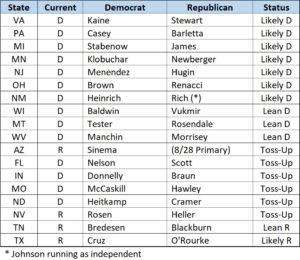Numerous pundits seems to think Democratic control of the Senate in 2018 is still a possibility. Okay, sure. A flipped nickel landing on its edge is also a possibility. The chances of the latter are about 1 in 6000. The chances of flipping the Senate are only slightly better.
The reality is that the 2018 Senate map is quite brutal for Democrats.
The calculus here is much less complicated than in the House, with Democrats defending substantially more “in-play” seats than Republicans this cycle.
Just last week, the picture got even a little bleaker for Democrats with former Governor Gary Johnson announcing his independent entry into the New Mexico Senate race. Johnson has zero chance of winning but he could be a possible spoiler. Hence, a previously safe (D) seat is newly in-play.
While I applied the same basic methodology here that I did for my analysis of the 2018 House races, the bottom lines are pretty simple.
Democrats need a net gain of 2 seats to take control of the Senate. Only 18 of the 33 Senate races this year are even remotely competitive and none of the other seats will change party hands. Of the 18 “in-play” seats, only 4 are currently held by the GOP. Thus, Democrats need to successfully defend every single one of the 14 seats they currently own in addition to flipping 2 of the 4 GOP seats.
From an analytics perspective, here’s my current breakdown of the 18 races, more-or-less in order of the best chance for a (D) win:

So, if you’re looking to contribute to a Senate campaign in hopes of flipping the Senate, just flip an 18-sided coin. Democrats have no significant margin of error.
To take control of the Senate, Democrats would first need to win all 10 of the races in which they currently have even a slight lead. They’d then need to either win all 6 of the toss-up races or replace up to two toss-up losses with wins in races where they are currently behind.
Yeah.
At this point in the cycle, a Democratic takeover of the Senate this year isn’t impossible. It’s just improbable.